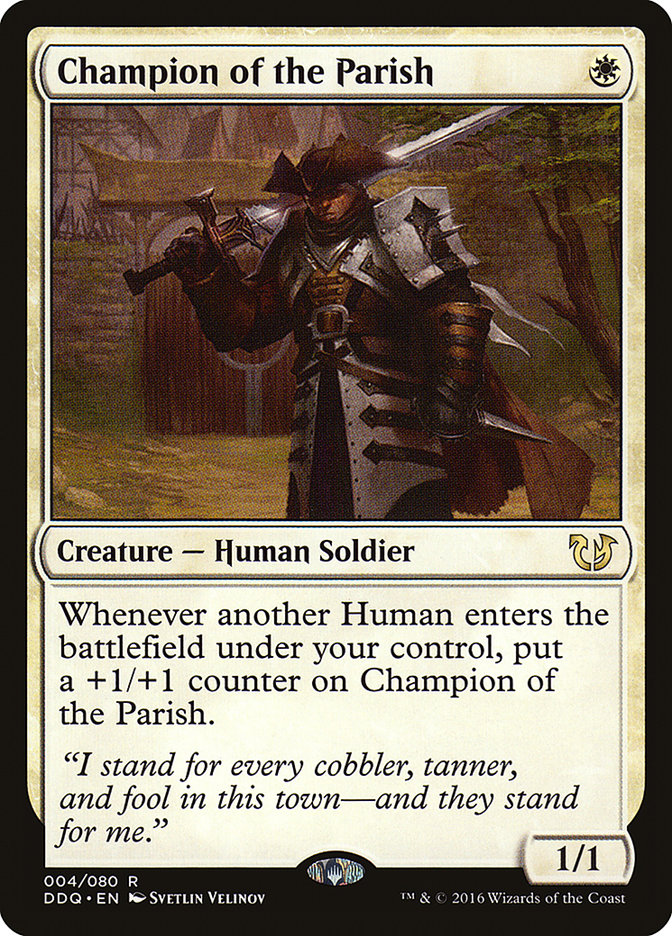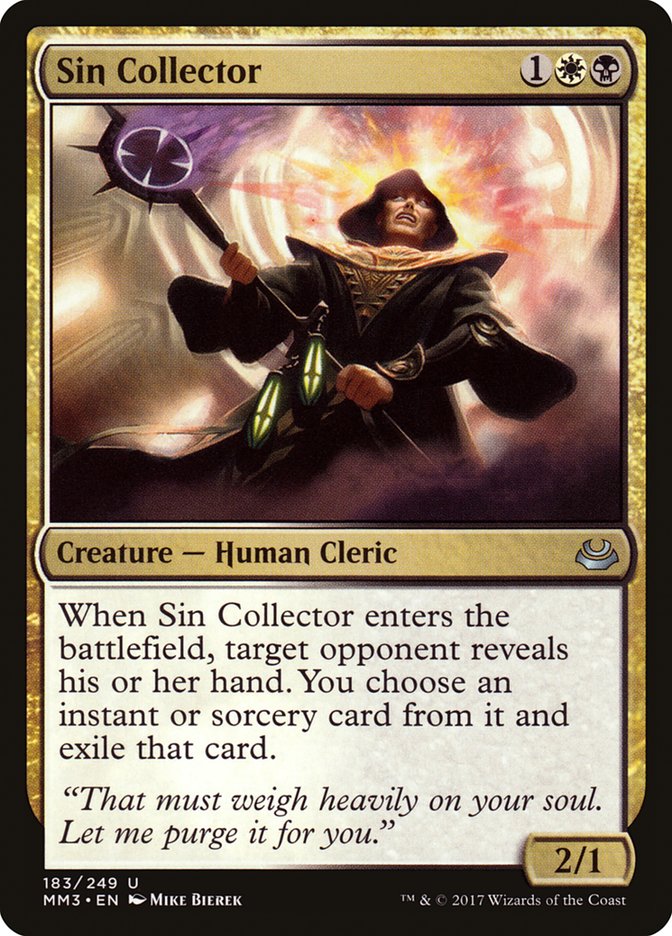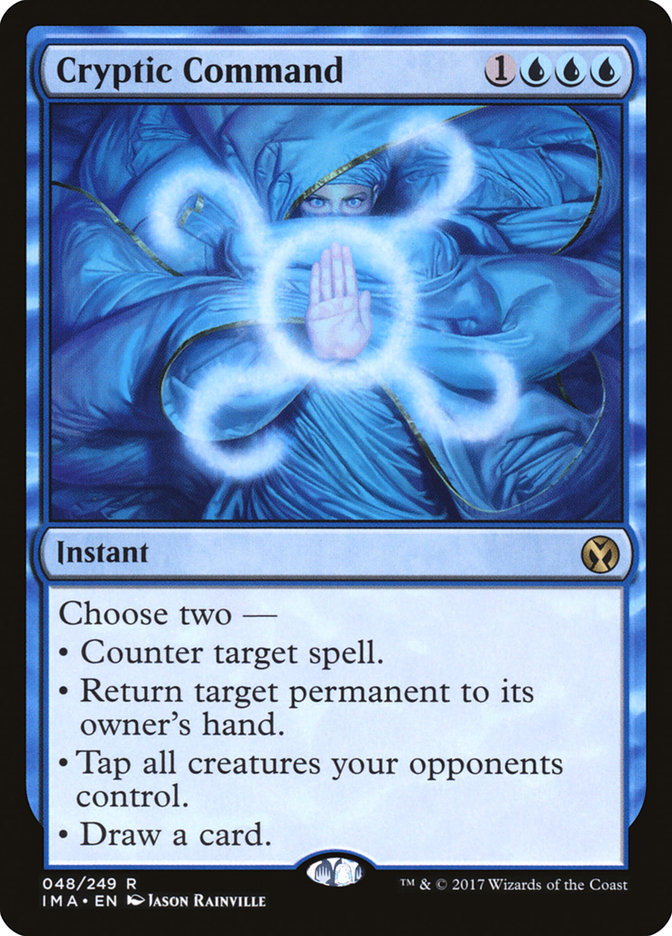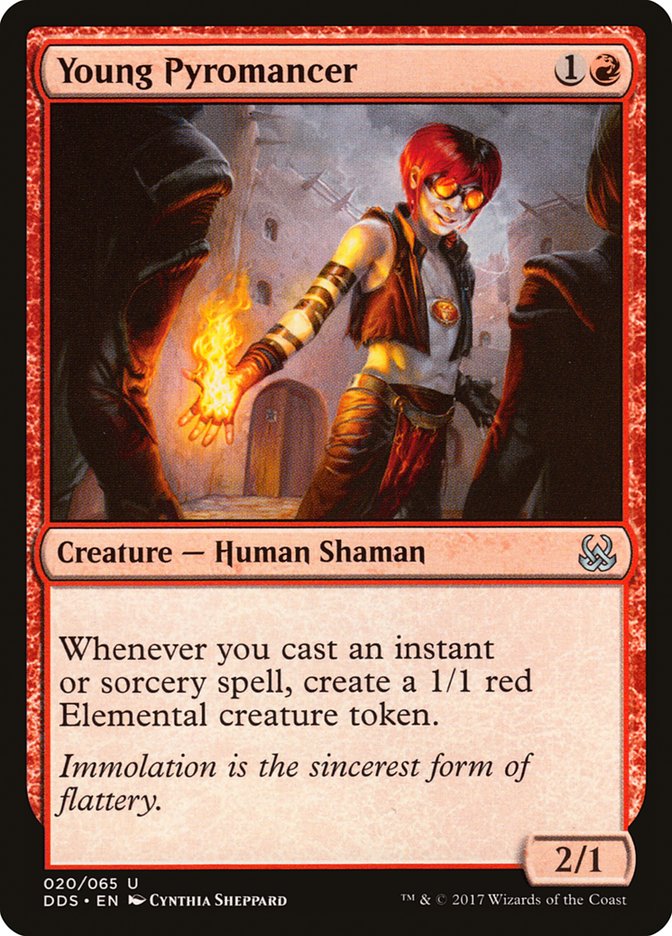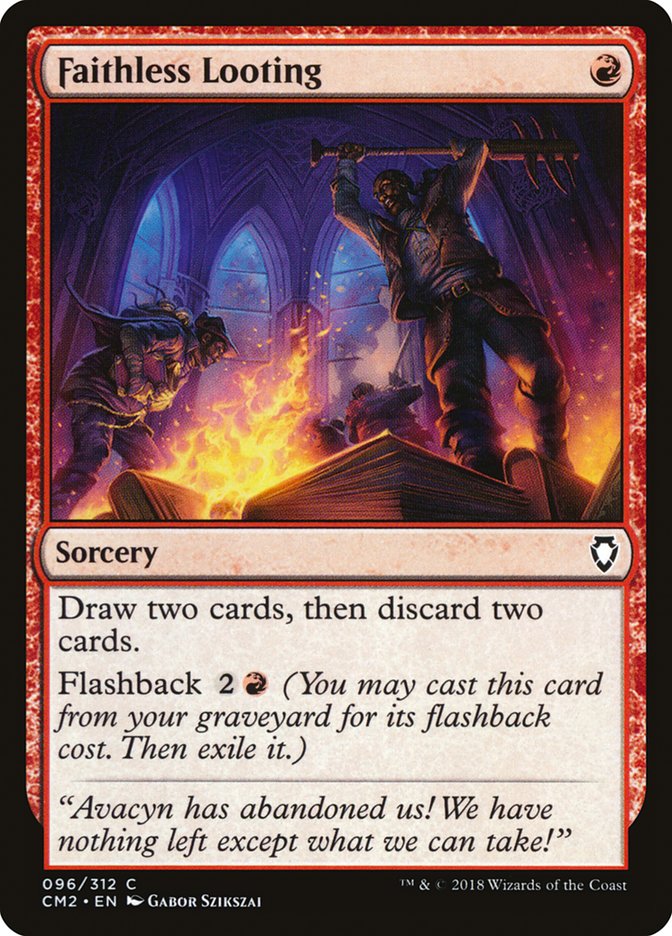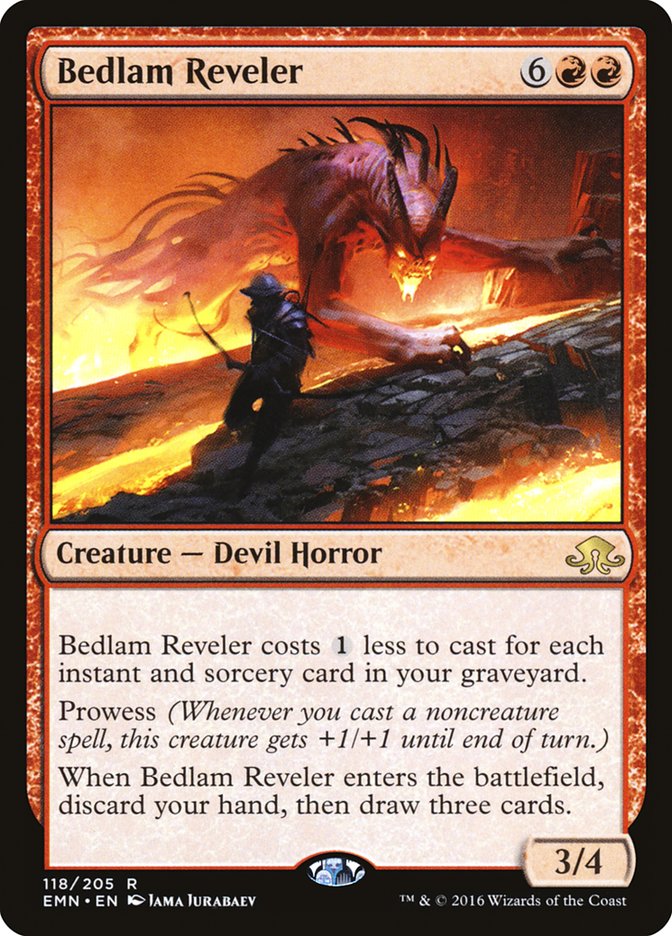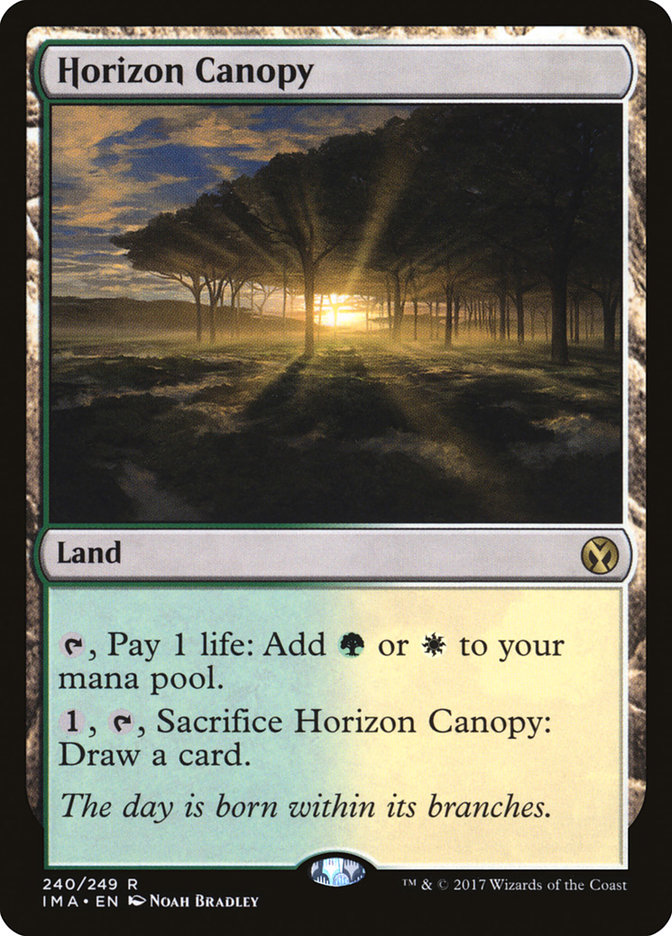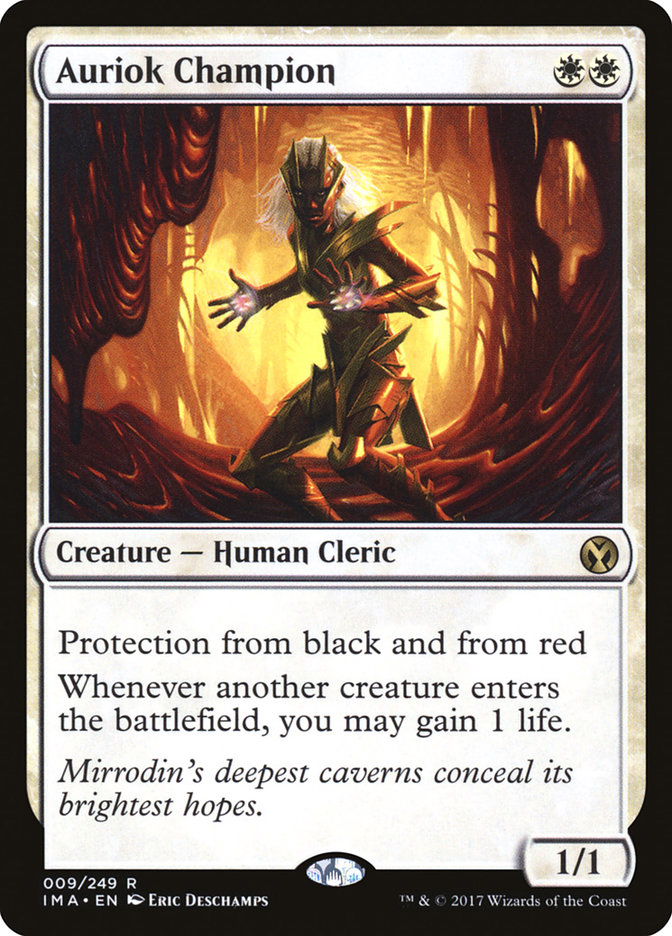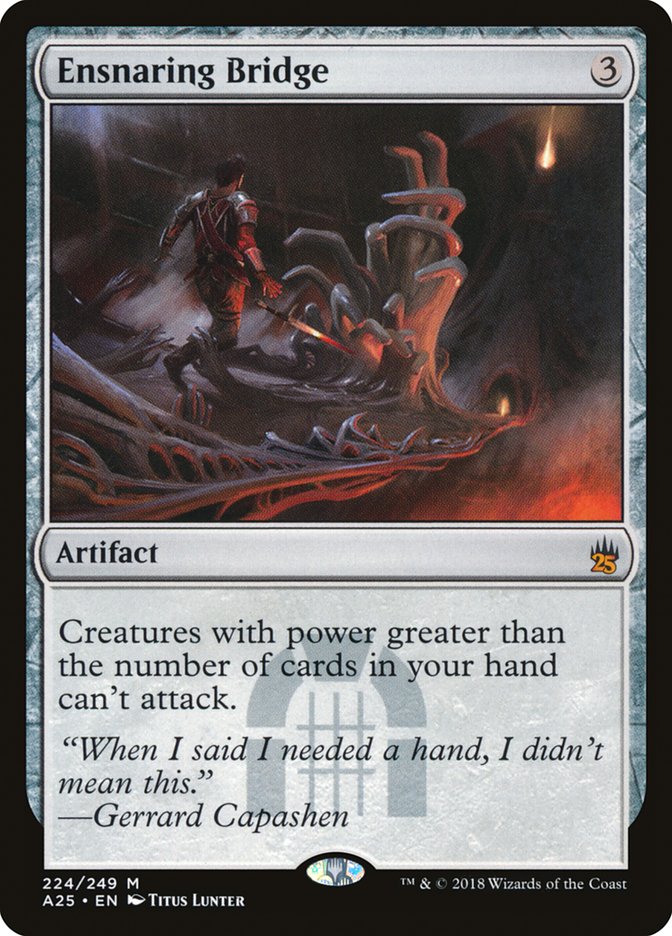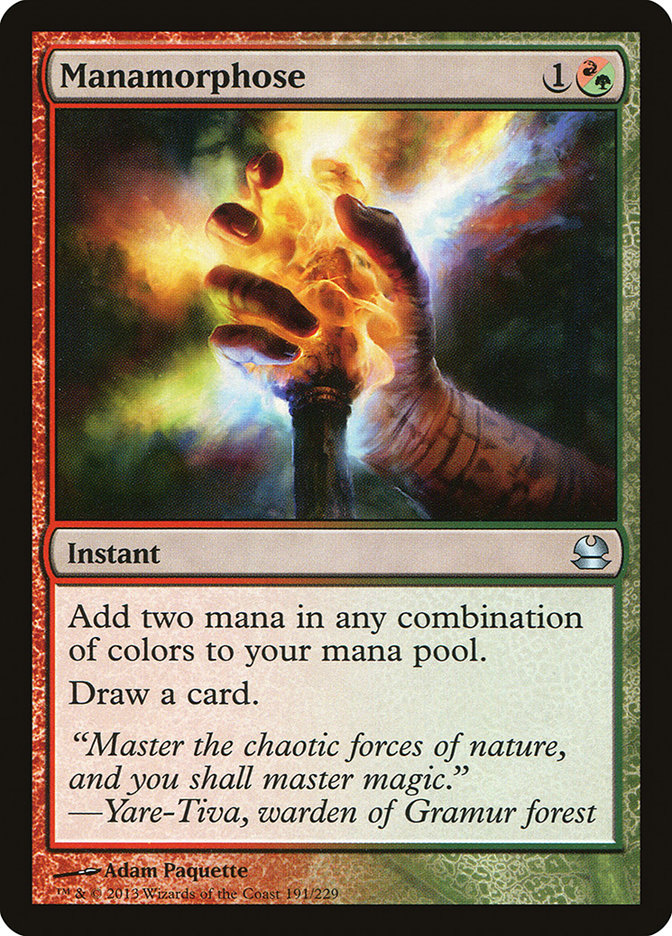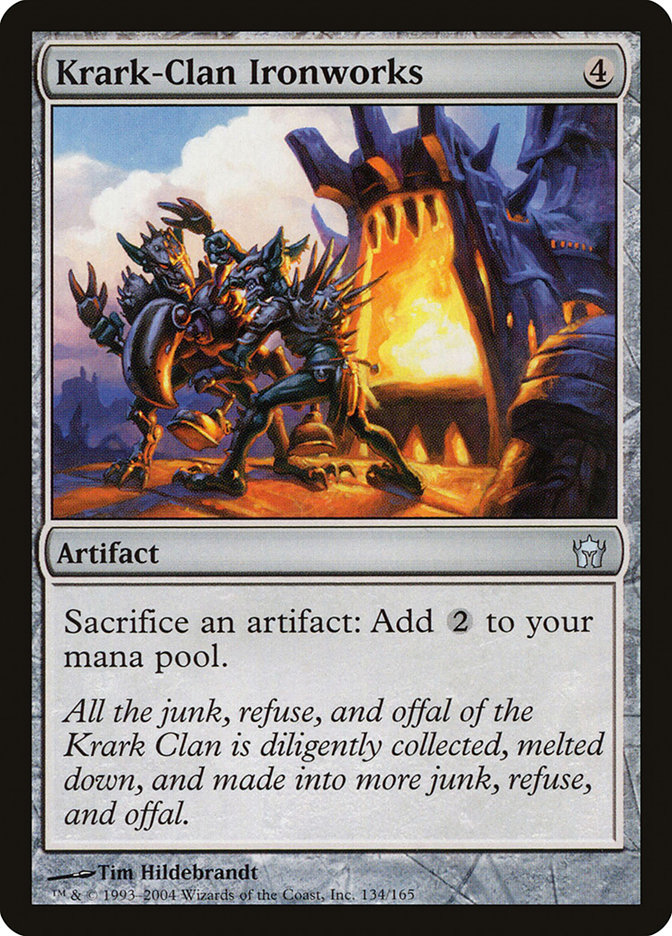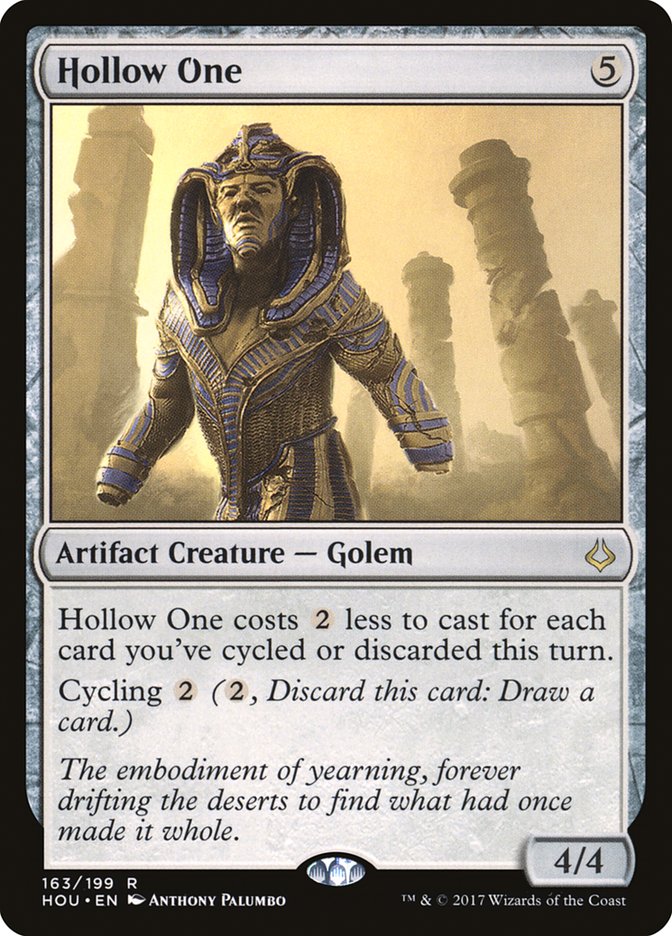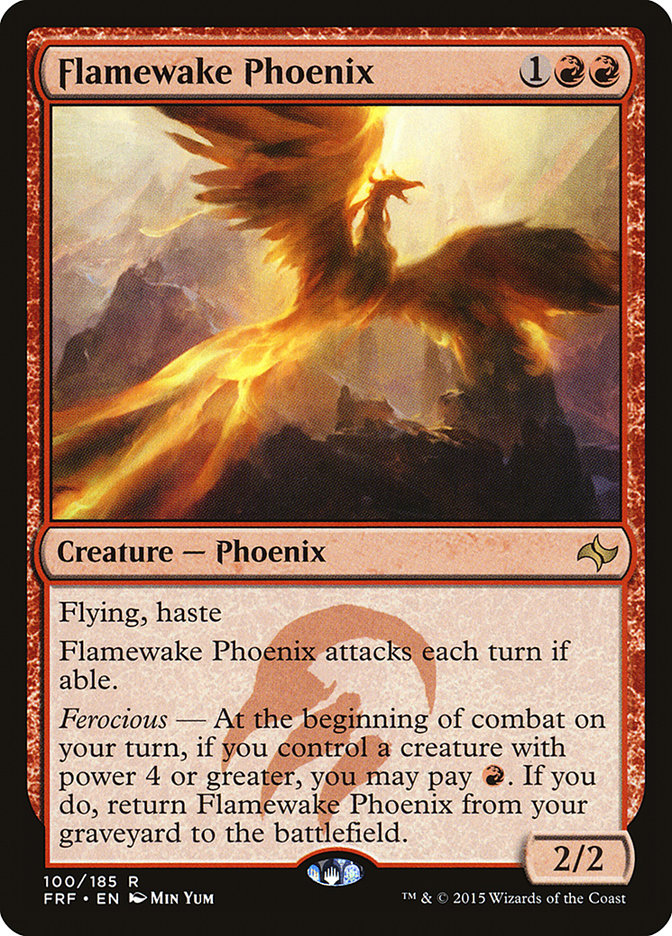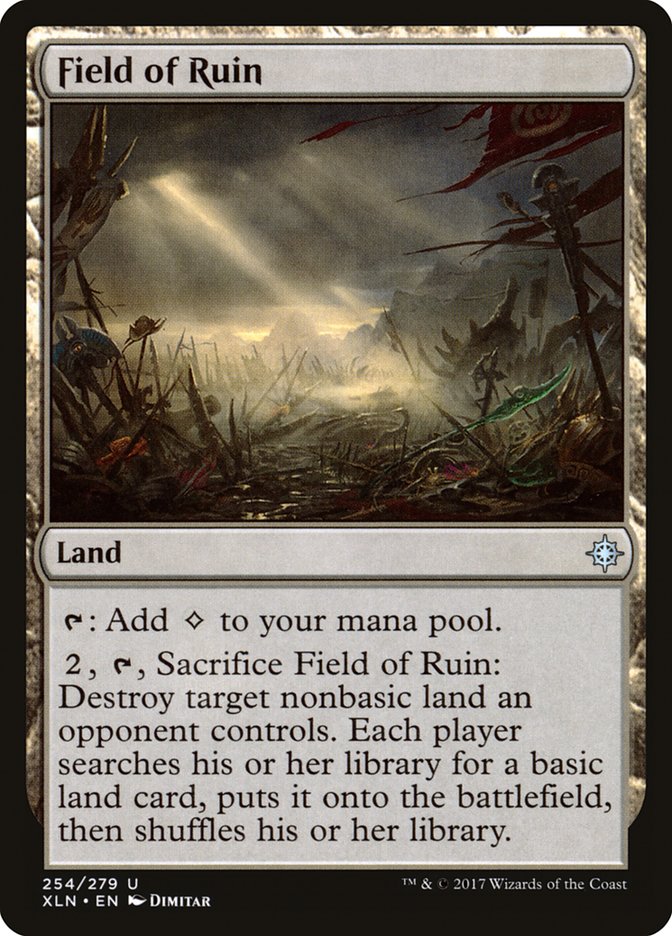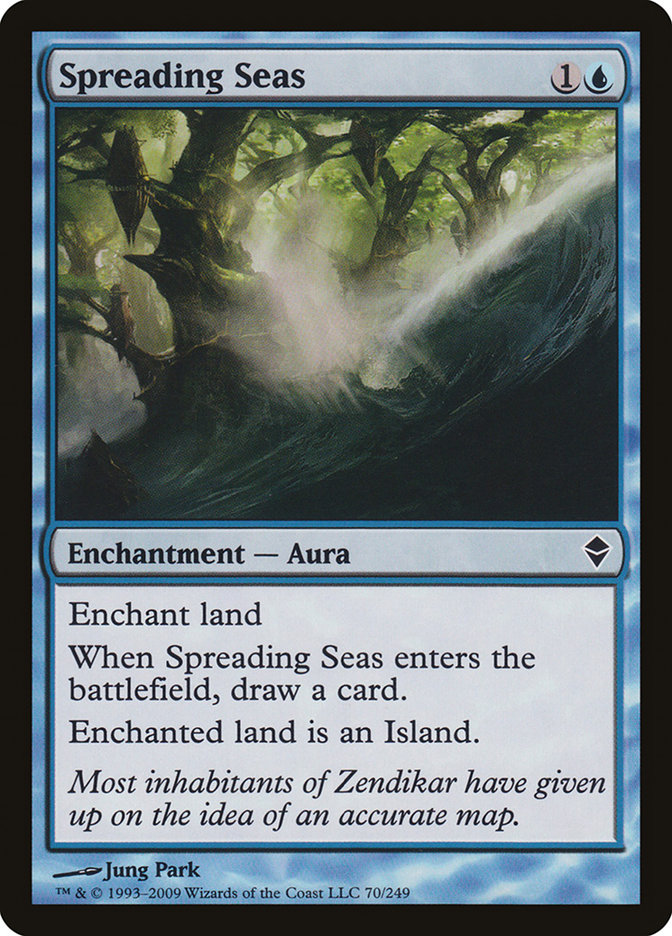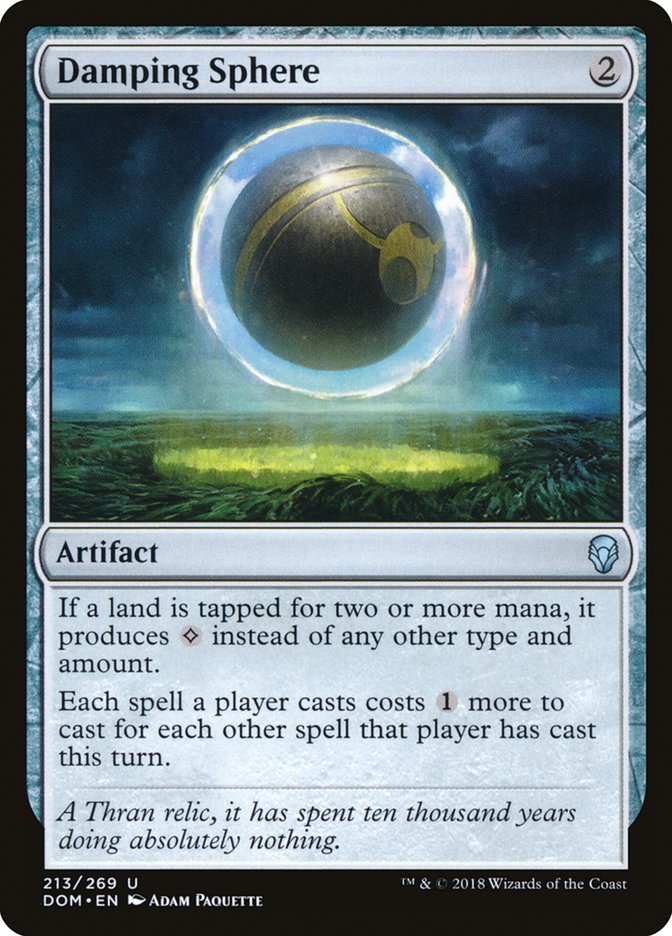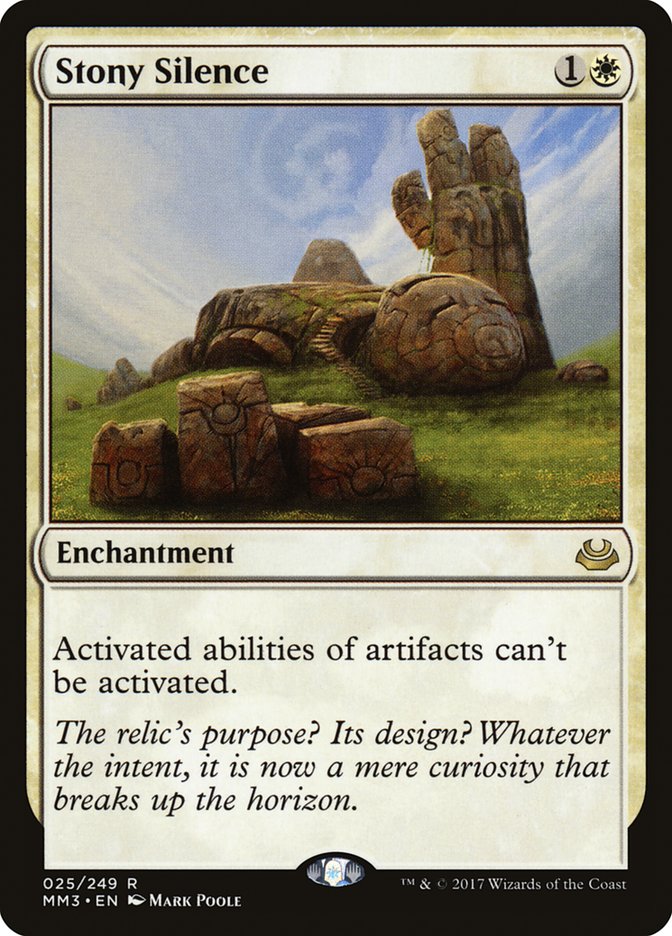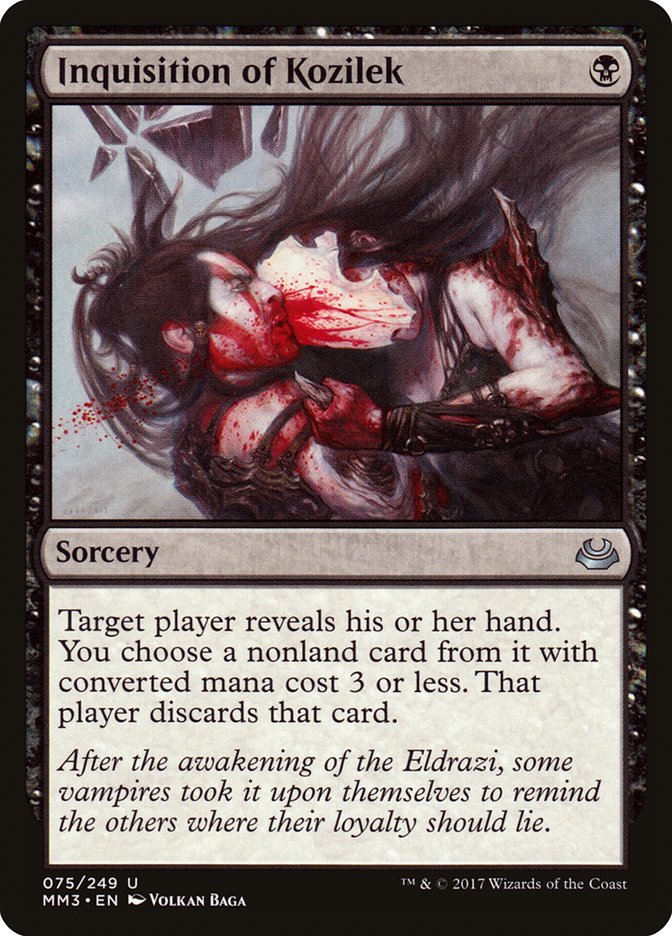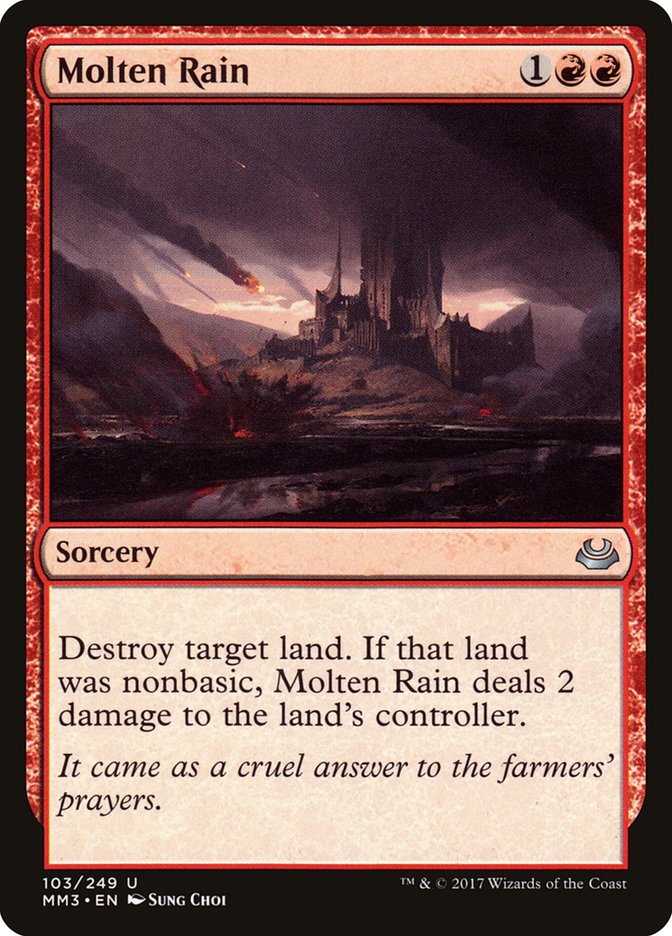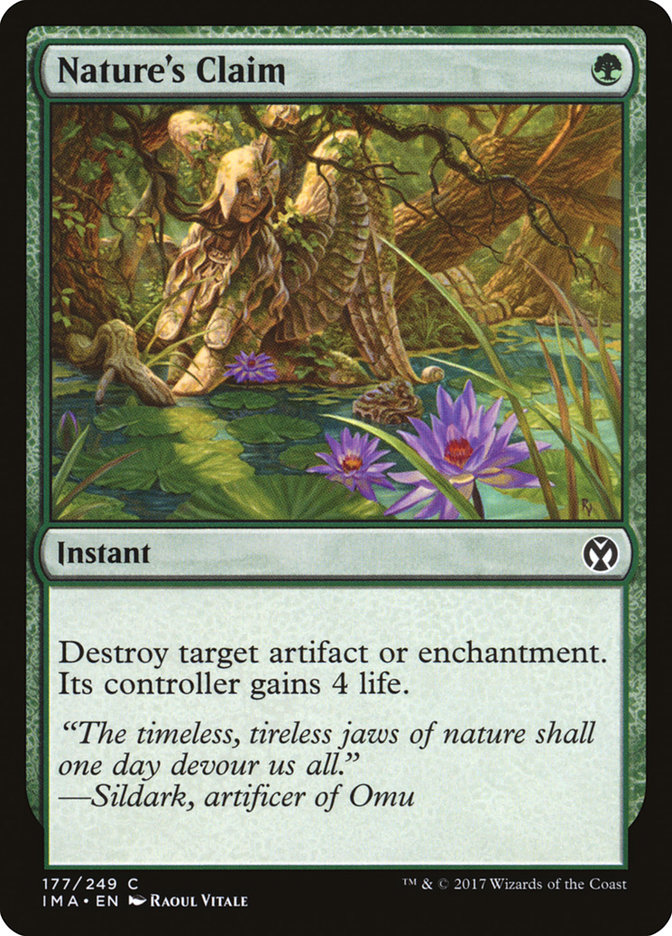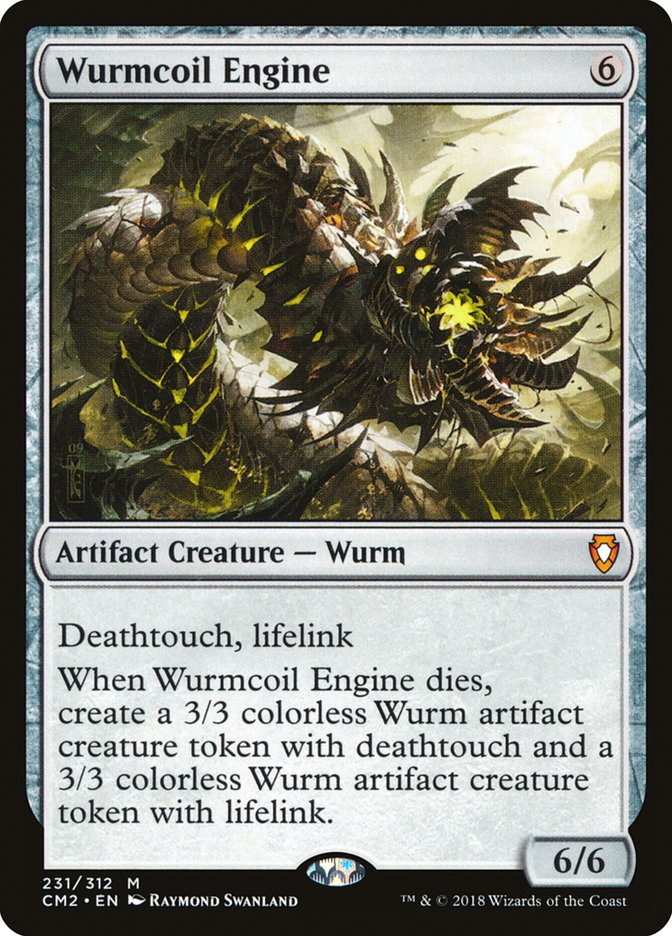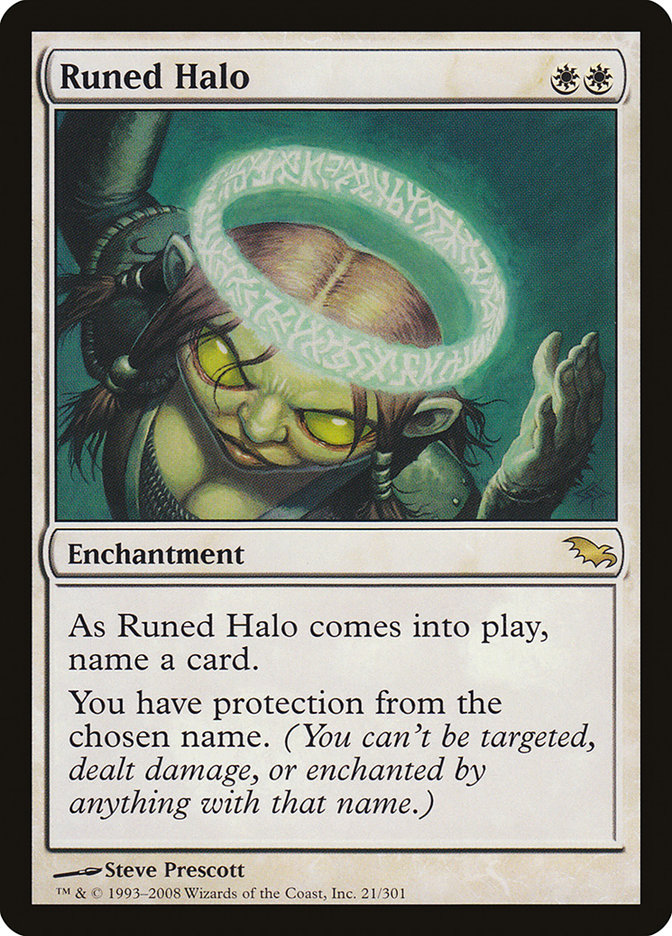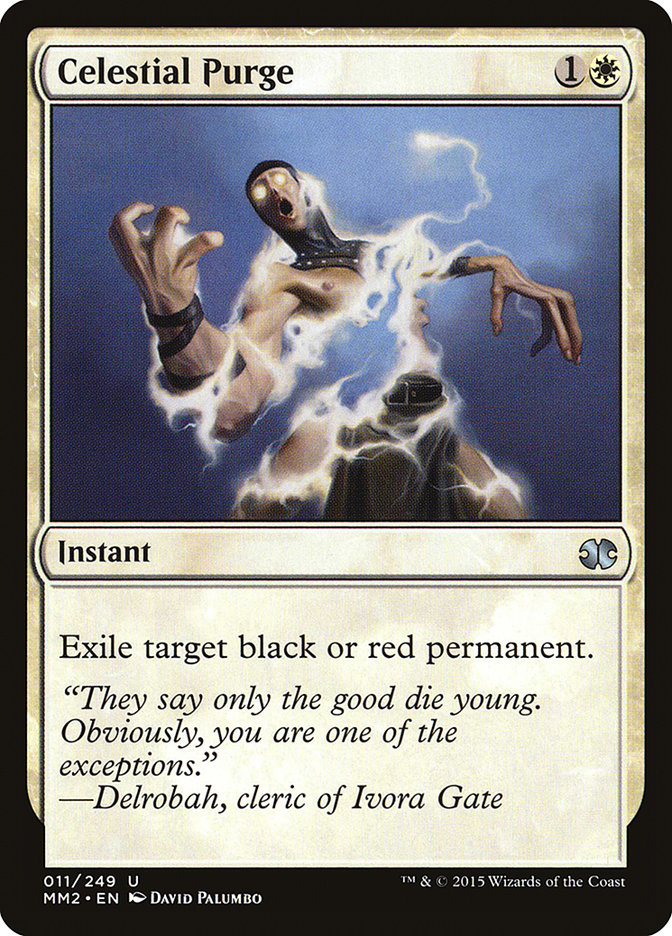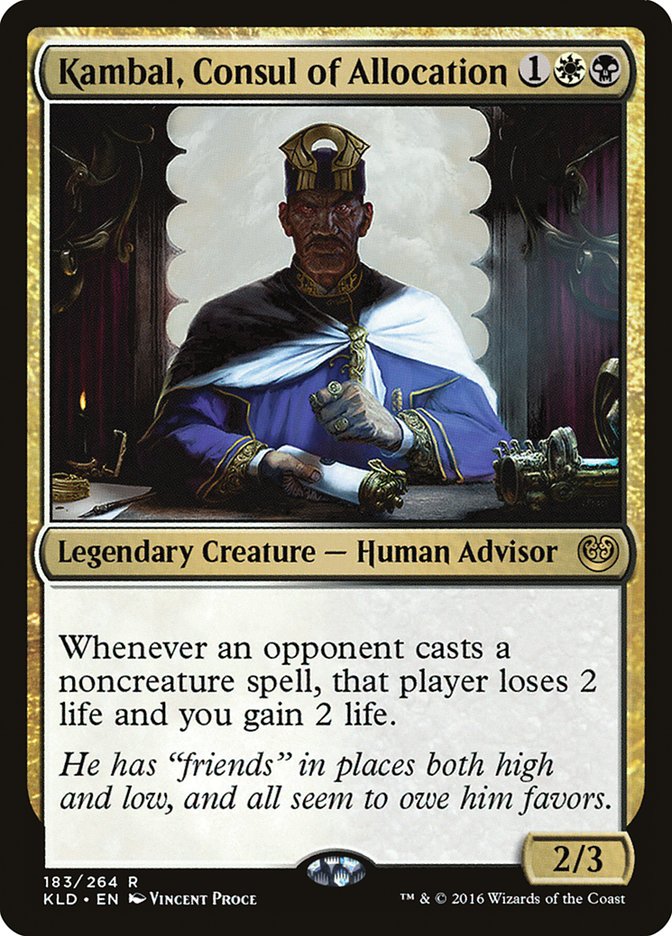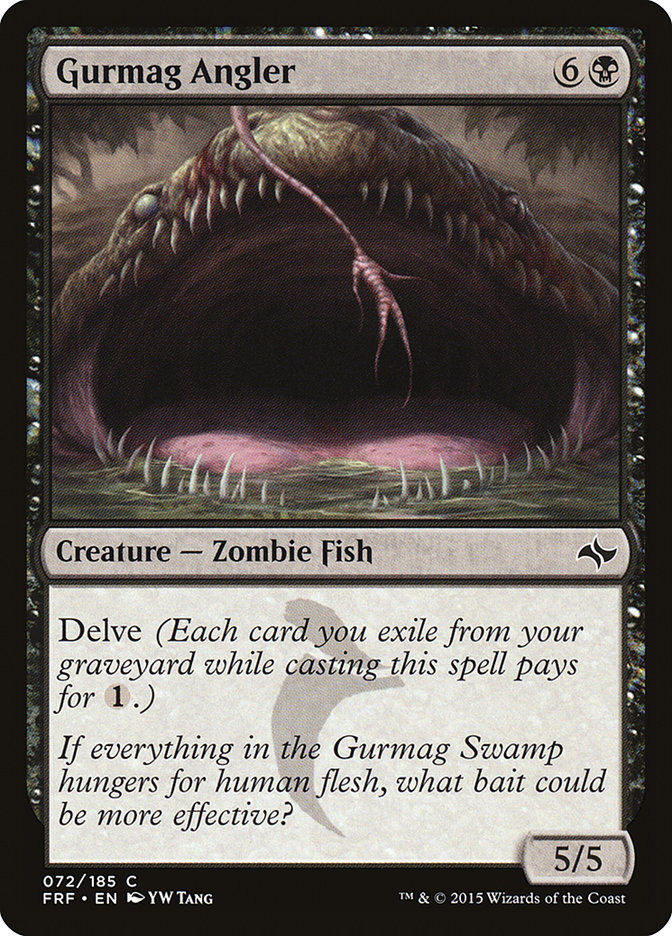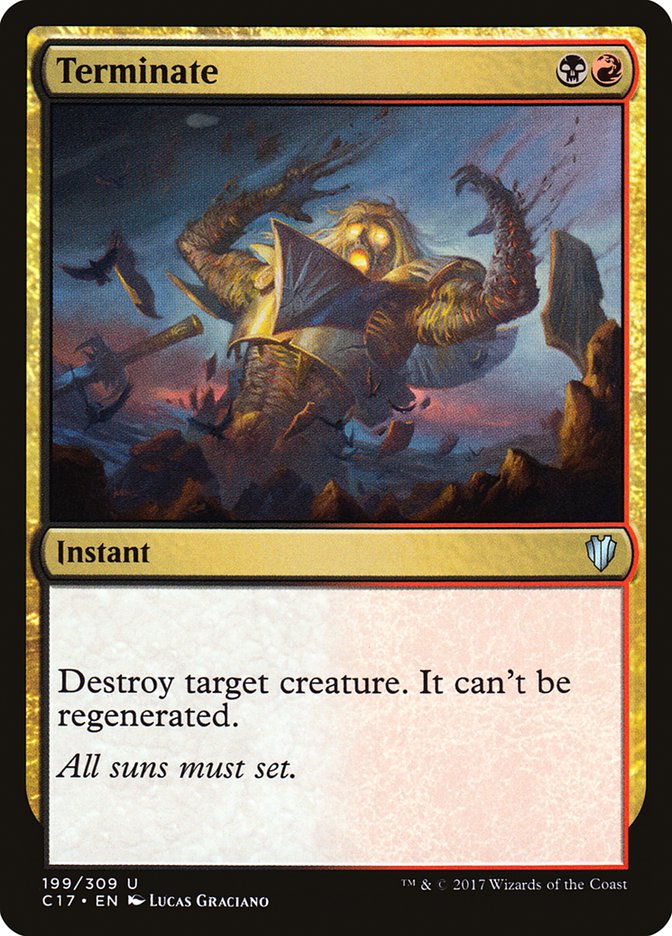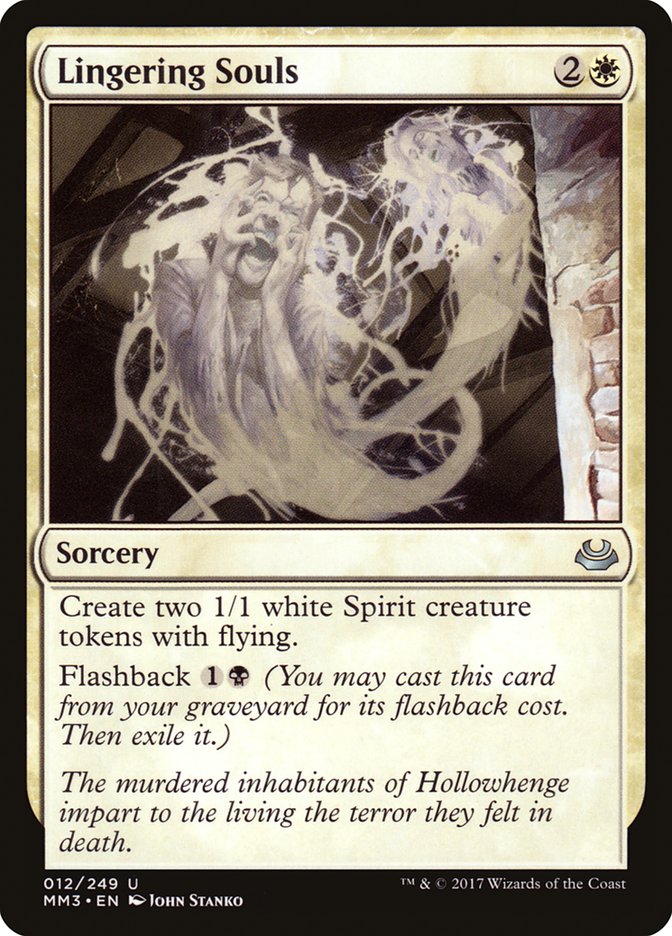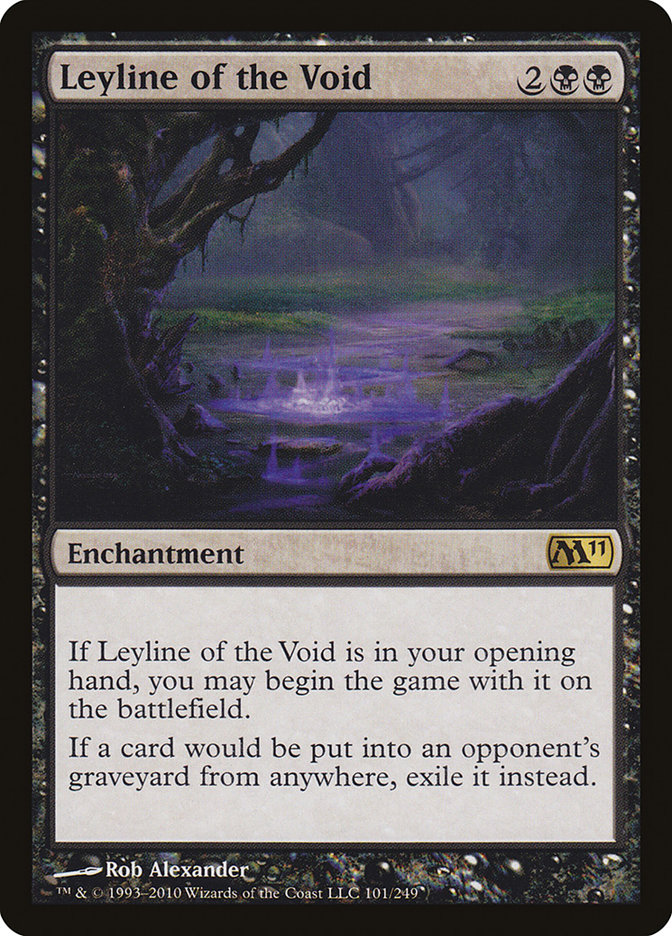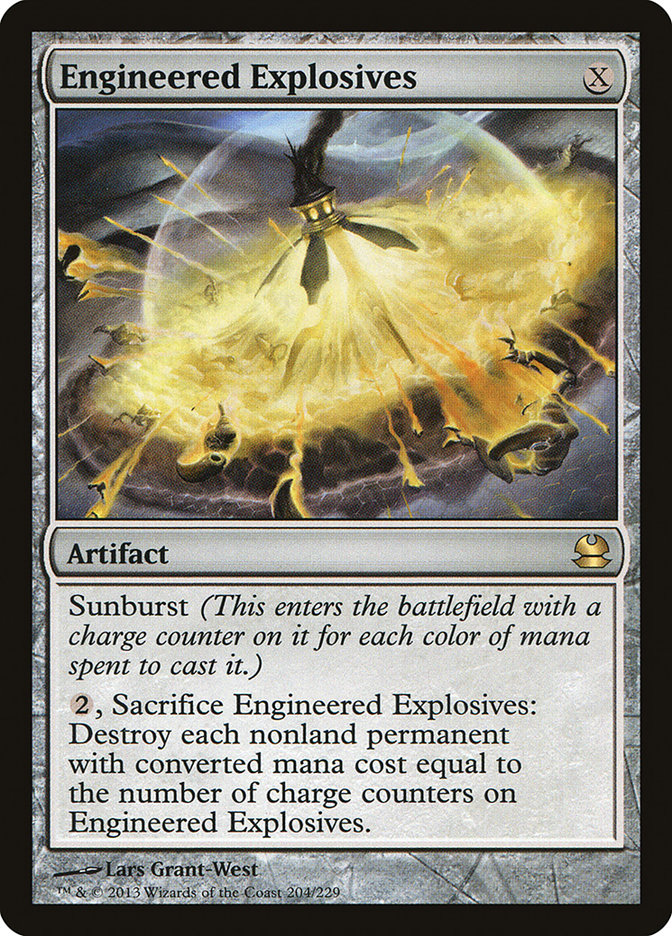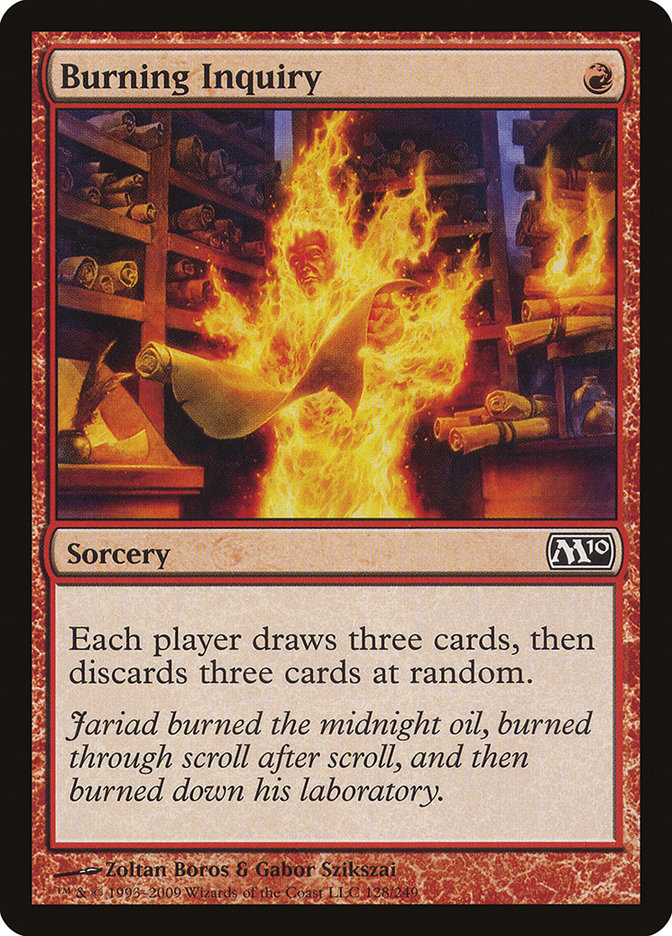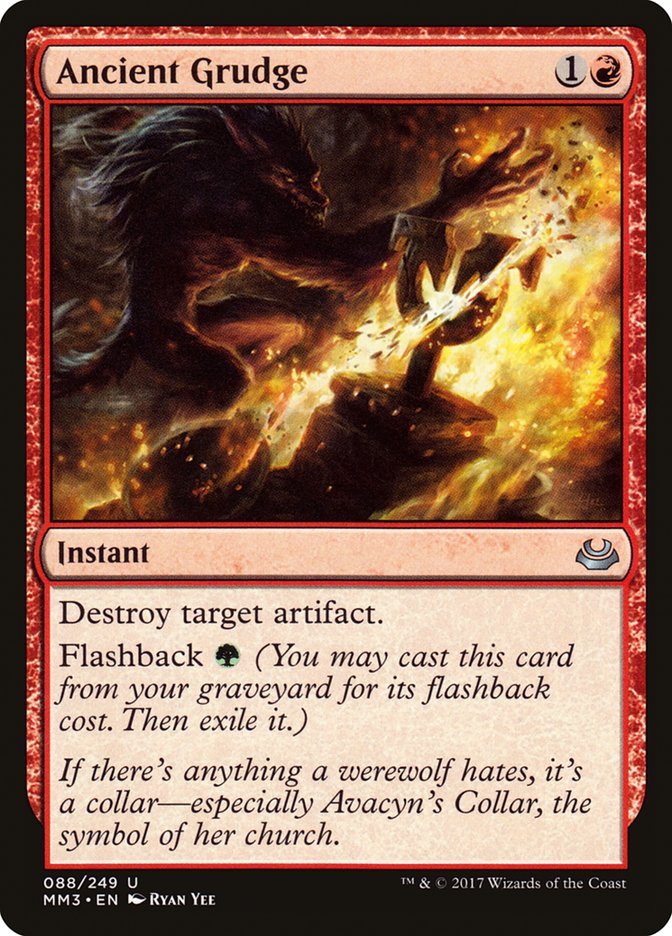According to recent event results, the top six decks in Modern are:
Creatures (37)
- 4 Meddling Mage
- 1 Dark Confidant
- 4 Noble Hierarch
- 4 Phantasmal Image
- 4 Champion of the Parish
- 3 Thalia, Guardian of Thraben
- 1 Kessig Malcontents
- 4 Mantis Rider
- 4 Reflector Mage
- 4 Thalia's Lieutenant
- 4 Kitesail Freebooter
Lands (19)
Spells (4)

Creatures (8)
Planeswalkers (6)
Lands (19)
Spells (27)

Creatures (4)
Planeswalkers (2)
Lands (25)
Spells (29)

Creatures (8)
Planeswalkers (1)
Lands (20)
Spells (31)

Creatures (6)
Lands (18)
Spells (36)

Creatures (24)
- 4 Street Wraith
- 4 Bloodghast
- 3 Gurmag Angler
- 4 Flamewake Phoenix
- 1 Tasigur, the Golden Fang
- 4 Flameblade Adept
- 4 Hollow One
Lands (18)
Spells (18)

This makes sense. Going back a few months, these are the decks that have
consistently performed across format evolutions, with a bit of recent
favorable winds pushing Tron up towards the top. Burn was a close seventh,
but its results are very recent and I have seen enough horrible outcomes
with it that I’m skeptical of its staying power.
What does this top of the metagame look like when they go head to head with
each other?
Humans versus Tron
Early:
-
On the play most Tron nut draws are good enough, and on the draw
Tron probably needs a turn four sweeper. -
Humans’ disruption is best if it can stop the assembly of Tron as
there are so many threats that do something. -
Humans functions best here when it has a strong clock with enough
disruption, not a bunch of slow lock pieces.
Mid to Late:
-
Tron activates an Oblivion Stone or Ugin, the Spirit Dragon and
wins if the game gets here.
Technical Details:
-
If Humans is going after Tron’s threats with disruption it should
do some clock math. If it costs more than a turn of Humans’ clock
to disrupt them, going for the fast kill is likely better. If it
costs exactly a turn, have fun with that judgment call. -
If Tron is on the draw with an Urza land and a Chromatic Star
effect, Humans might just want to Meddling Mage Sylvan Scrying.
Sideboarding:
-
Tron must worry about Damping Sphere. Hedging with some Nature’s
Claims is low cost as it still hits Aether Vial, and killing a
Chromatic Star to gain four life can save it from a turn four death
in spots. -
If Tron runs out Oblivion Stone without activation mana it can get
Reclamation Sage’d, but that is a narrow concern. -
Thragtusk is fine but unexciting for Tron. The Beast doesn’t win
the runaway games Tron loses.
Overall:
Tron was solidly ahead before Dominaria. It is still ahead but
lost enough percentage points in sideboarded games to make me worry that
Humans is no longer a reason to play the deck.
Humans versus Blue Control
Early:
-
Humans is trying to clock Blue Control under a sweeper. Blue
Control has enough other answers to make the usual disruption
merely temporary. Humans wants to present a clock and pepper in
disruption at the most inopportune times, but often it must hope to
fade a sweeper.
Mid to Late:
-
If given any window, the Blue Control deck is going to stick a
planeswalker and win the game. Slow threat deployment from Humans
doesn’t work against Teferi, Hero of Dominaria and Jace, the Mind
Sculptor.
Technical Details:
-
Early Meddling Mages are often better off trying to hit Snapcaster
Mage or cheap removal as the sweepers have too many names these
days. -
Draw step Aether Vial activations lets Kitesail Freebooter and
Meddling Mage cover Terminus in response to the Miracle trigger.
Sideboarding:
-
The big swing here is Humans gaining Sin Collector. I suggest
you watch Game 3 of the SCG Tour Minneapolis Finals from May
here
. If Sin Collector dies, the Control player is still down a card
which means their sweeper doesn’t also open up multiple other
cards. -
Blue Control wants to cut all the counter magic. One of the little
“gotchas” is that Celestial Purge is good as it covers all the
discard creatures to prevent Phantasmal Image-ry and Mantis Rider.
Overall:
Things are even worse than they were in the Tron matchup. Blue Control is a
heavy favorite here.
Humans versus Mardu Pyromancer
Early:
-
Mardu can lose games early if it doesn’t do enough things for one
mana. It doesn’t have reset buttons, so hands of Lingering Souls
will be chump blocking giant Humans and dying. -
Conversely, Thalia, Guardian of Thraben is Humans’ best hope of
running away with a game. Making their one mana stuff cost two then
overrunning them is good stuff. -
Champion of the Parish isn’t the best one-drop. Making multiple
plays a turn via Noble Hierarch is how you get ahead of the cheap
removal, and Champion not dying early is often a sign anything
would have killed them. -
Young Pyromancer can run away with a game if Mardu gets to
establish it early. Humans has Reflector Mage to briefly stall it,
which makes multiple Pyromancers a liability.
Mid to Late:
-
At the start of the mid-game, if Humans is ahead it can stay ahead
and can close, if it is behind Mardu can just keep pace turn for
turn and win. -
Mardu has an easy win button of keeping the battlefield clear and
slamming a Blood Moon at the start of the mid-game. This turns
Humans being behind into a clean-cut win. -
Given parity, mana flood often decides the game. That means Mardu
needs to maximize Faithless Lootings, holding extra lands and only
filtering less than two dead cards if really needed. -
One way Humans has to get back into a losing game is Phantasmal
Image on Bedlam Reveler. Phantasmal Images should be saved for
worthy targets, and Mardu casting Bedlam Reveler without a
discard-cleared path is a definite risk.
Technical Details:
-
Just watch the Gerry Thompson versus Javier Dominguez
match from Pro Tour Rivals of Ixalan, there two master
class players battling this out.
-
Humans wants to hold extra lands and Aether Vials in hand to
protect topdecks from Kolaghan’s Command discard. -
Meddling Mage should choke Mardu’s assumed next on-curve play or
just aim for their best answer of Lightning Bolt.
Sideboarding:
-
Humans wants to bring in too many three-drops. Izzet Staticaster is
key to managing tokens, and I think Humans must hedge for Ensnaring
Bridge with Reclamation Sage, and Sin Collector is a must-have. I
think this means they shave on Reflector Mage and weak two-drops
like Meddling Mage. -
Auriok Champion is nice for Humans to have and gives it a long-term
advantage. Mardu really needs Engineered Explosives or a similar
out to the card these days. -
Mardu wants to trim cards that get punished by Thalia, like
Manamorphose, or discard that is bad to topdeck.
Overall:
Mardu is ahead by default, but Humans has a clear route to wins. Get ahead
on tempo, pressure hard, and don’t flood.
Humans versus Ironworks
Early:
-
Anything short of the Humans’ disruption hardlock is fragile, with
the hardlocks being three Meddling Mages set to Krark-Clan
Ironworks, Engineered Explosives, and Pyrite Spellbomb or two
non-Image Mages that you then boost to 3/3s to dodge a Pyrite
Spellbomb. -
Thalia, Guardian of Thraben is a bit of a bust against Ironworks
fast mana and the fact Engineered Explosives counts the extra
payment for sunburst, making Explosives for two counters still cost
two mana. - As with Tron, Humans wants a good clock with some disruption.
Mid to Late:
-
Ironworks needs to be careful about deploying Scrap Trawler as a
chump blocker as getting it Reflector Mage’d is a Time Walk
problem. Myr Retriever infinite loops are easier to live without as
a couple Engineered Explosives activations is enough to safely pass
turns and kill later.
Technical Details:
-
Humans curves that produce lethal threats that cost one or three
alongside hate are slightly better as those don’t die to Engineered
Explosives.
Sideboarding:
-
Humans has no hope of a hardlock against Ironworks’ sideboarded red
removal. Even Kambal, Consul of Allocation or Kataki, War’s Wage
just dies. Keep hands that are clocks with some disruption, not
slower ones. -
Damping Sphere exists but dies to Engineered Explosives. From the
Ironworks side I wouldn’t worry too much about having Nature’s
Claim.
Overall:
I would rather be on the Ironworks side of this, which explains the recent
success of that deck.
Humans versus Hollow One
Early:
-
Hollow One’s best draws produce multiple very early 4/4s or 5/5s.
The goal is to clock Humans as fast as possible with multiple
things they have to chump block. Multiple forced chump blocks
eventually break parity and it’s Reflector Mage proof. -
Humans wants to rapidly grow a creature to 6/6 so it can block
anything. If the game goes longer, Humans overwhelms Hollow One. If
Hollow One has removal, it should aim it at things that can grow. -
Phantasmal Image copying a big Hollow One creature forces a removal
spell and is big a problem.
Mid to Late:
-
A turning point against slower Hollow One hands is if Humans gets
to double block something profitably. This often is the result of
Reflector Mage’s 2/3 body after an attack slow down. -
Hollow One’s plan in longer games is to close with Flamewake
Phoenixes and burn. This makes Mantis Rider important for Humans,
allowing them to stymie these chip shot attacks.
Technical Details:
-
Adding a +1/+1 counter to Kitesail Freebooter also makes it an
effective blocker for a 2/2 flier. -
Fatal Push can target a Phantasmal Image acting as one of Hollow
One’s high drops.
Sideboarding:
-
Humans gains Reclamation Sage to stop Hollow One’s fast draws.
Multiple delve creatures still get bricked by Reflector Mage, and
now Hollow Ones permanently disappear. -
Hollow One gets Grim Lavamancer and Engineered Explosives. Simple
recursive threats with this great interaction can take games that
would be unwinnable for the base Hollow One configuration.
Overall:
Humans has too many tools that mess up Hollow One’s progression. Their best
draws are good enough, but sometimes just barely.
Tron versus Blue Control
Early:
- Jeskai Control is just going to die. Let’s talk about U/W.
-
Phase one for U/W is keeping Tron off Tron. There might be a turn
where Tron gets to run a threat into a counter before U/W destroys
a land, but multiple turns almost assures Tron wins. -
If Tron stumbles in reassembling, a planeswalker can quickly run
away with the game. Jace is optimal, Teferi can do it but isn’t
also disruption.
Mid to Late:
-
Tron hits seven mana after U/W has spent some time stopping that,
often by finding a Forest on every Field of Ruin. -
The mid-game is about U/W answering every threat Tron deploys
appropriately. It needs to Path to Exile creatures and counter
planeswalkers. -
The late game starts when U/W has run the Tron player’s hand out of
threats. The goal then becomes starting to kill the Tron player
without exposing itself to a blowout. -
One blowout is U/W letting two threats get exiled by the same
Ulamog, the Ceaseless Hunger or die to the same Oblivion Stone.
Threat pacing is key.
Technical Details:
-
In early games, if U/W can keep Field of Ruining the same land it
is better as there are just less copies left to find with Ancient
Stirrings. -
With Spreading Seas, U/W doesn’t want to start by targeting the
same land it Field of Ruin’ed if possible. This is because Oblivion
Stone eventually unlocks those lands making it harder to re-lock
Tron. -
U/W does not want to Detention Sphere a planeswalker if possible,
as it is easy for Tron to break the enchantment with a threat and
suddenly have multiple issues at once. -
If Tron draws a Sanctum of Ugin later on, it is usually better to
save it in hand until it can be immediately triggered to minimize
the Field of Ruin window. -
Celestial Colonnade is often the best U/W win condition as it
doesn’t die to Oblivion Stone, allowing U/W to disregard those. -
U/W can Cryptic Command to counter Ulamog, the Ceaseless Hunger and
bounce one of the targets. This doesn’t work so well versus World
Breaker.
Sideboarding:
-
U/W gains a lot of ways to hold Tron in the early game here. Things
get real rough then and often stop at the planeswalker taking over
the game phase.
Overall:
U/W doesn’t want to play Tron, but it has a plan. Jeskai is still dead.
Tron versus Mardu Pyromancer
Early:
-
Mardu needs to assemble a clock and use discard to stop Tron’s
assembly process. Young Pyromancer is key. -
Walking Ballista from Tron stops Mardu’s fast clocks without full
Tron, making it one of Tron’s best threats.
Mid to Late:
-
If Mardu lands a Blood Moon, it is still under a clock where Tron
can hit seven mana the normal way or just activate an Oblivion
Stone. Blood Moon with no action is an easy way to lose. - Tron wins eventually. Big spells are too strong.
Technical Details:
-
Tron wants to avoid running into Kolaghan’s Command on all fronts.
Don’t cast Walking Ballista into nothing if you might need it,
don’t play an extra land for no reason and run out of discard
fodder.
Sideboarding:
-
Tron gets Thragtusk, but it does not want Thought-Knot Seer as it
is uncastable under Blood Moon. -
Spatial Contortion for Kambal, Consul of Allocation and Young
Pyromancer might be better than Nature’s Claim to hedge for Blood
Moon. - Mardu has obvious land destruction and a lot of finger crossing.
Overall:
Tron is a massive favorite here, as Gerry
often runs into on The GAM Podcast.
Tron versus Ironworks
Early:
-
Tron’s big issue here is that none of its threats do quite enough.
Ironworks can out mana a Karn Liberated via Mind Stone or Mox Opal
and Oblivion Stone can be run right through with an untapped Buried
Ruin. Tron needs multiple things to bury the Ironworks player. -
Relic of Progenitus is fairly easy to leave up and can represent a
big problem for Ironworks given the other angles of pressure.
Mid to Late:
- Colorless combo mirrors end early.
Technical Details:
-
Ironworks should consider Dismember mid-combo as a thing that can
happen to them. -
Ironworks should consider slow rolling value lands like Inventors’
Fair so Karn or a Ghost Quarter doesn’t eat them.
Sideboarding:
-
Tron gets Nature’s Claim as another combo breaker and more
graveyard hate, but also Thought-Knot Seer as a way to force
Ironworks to jump through big hoops. The other ways to stop
Ironworks’ main engine let them recur it with Buried Ruin or make
one shot big mana, Seer just doesn’t. -
Ironworks gets Nature’s Claim, which is a key part of managing
Relic of Progenitus and randomly stopping Tron by getting
Expedition Map.
Overall:
Ironworks is a favorite. Even if it wasn’t a bit faster it has ways to
steal games from Tron nut draws in ways few other decks do.
Tron versus Hollow One
Early:
- This is an uninteractive race between the two decks to start.
Mid to Late:
-
Tron needs to stick a specific threat once it hits Tron. Oblivion
Stone and Karn Liberated don’t cut it, and Ugin, the Spirit Dragon
misses Hollow One and must sacrifice to clear Gurmag Angler. -
Relic of Progenitus in this phase can team up with Oblivion Stone
to buy Tron a lot of time.
Technical Details:
-
Hollow One can Lightning Bolt its own stuff to stop lifelink or to
dodge an exile.
Sideboarding:
-
Not much changes on either side. Thragtusk is a minor bonus, but
not a fundamental shift.
Overall:
Hollow One is ahead on average, but either deck’s best hands beat the
average.
Blue Control versus Mardu Pyromancer
Early:
-
Blue Control can quickly die if it can’t kill a Young Pyromancer,
giving Mardu an early discard exploit to focus on. -
Blood Moon can be a huge issue for Blue Control, especially since
Cryptic Command is a key component for the long game.
Mid to Late:
-
Blue Control wins if a planeswalker gets running, otherwise Mardu
has less lands and more card draw. -
Bedlam Reveler is the only sure must-counter, and Kolaghan’s
Command recurring it usually is. - This is another Faithless Looting maximum value matchup.
Technical Details:
-
Blue Control needs to be careful with its life total. Six or eight
life can be scary burn ranges. -
Blue Control should try to keep the Spirit token count from
Lingering Souls low if it plans on landing a fast planeswalker.
Path to Exile on one sucks, but sometimes it maths out to Teferi
not dying to Lightning Bolt. -
Jace, the Mind Sculptor is not safe at three loyalty. Scry or
fateseal with it as soon as it resolves.
Sideboarding:
-
If Blue Control has Rest in Peace, it’s game-breaking. All of
Mardu’s best grindy action is graveyard-based. -
Mardu’s Molten Rains are fairly annoying for Blue Control and can
trap their average draws in some bad spots.
Overall:
Mardu is ahead due to a higher density of card filtering and advantage, as
well as a better plan to steal games.
Blue Control versus Ironworks
Early:
-
Blue Control sticking a turn two Search for Azcanta is good, but
otherwise the goal is to just not die and hit every land possible. -
Ironworks just does normal stuff and shrugs off counters. Buried
Ruin means nothing is really wasted if it gets countered.
Mid to Late:
-
Blue Control only starts casting planeswalkers when it can also
leave up counter magic. -
If Blue Control can’t stick a card advantage engine, it eventual
gets overrun by Ironworks cantrips and value lands.
Technical Details:
-
Blue Control needs to fill its graveyard for Logic Knot, so firing
off an early Lightning Bolt does things. -
Ironworks should be a bit careful with its value lands against
Field of Ruin, and it should be careful to not expose Scrap Trawler
prior to a sacrifice outlet to protect it from Path to Exile.
Sideboarding:
-
Blue Control gets the obvious hate permanents and the game focuses
on protecting them. - Vendilion Clique is quietly insane as a threat-disruption combo.
-
Ironworks also gets good value out of Ghirapur Aether Grid as
another hard to handle threat that stops all of Blue Control’s win
conditions through Stony Silence.
Overall:
Despite the powerful hate, Ironworks has a lot maneuverability to fight
through it. I think a well-practiced Ironworks player is the favorite
against Blue Control.
Blue Control versus Hollow One
Early:
-
Hollow One just makes creatures, and it is on Blue Control to blunt
the fast Hollow One action before taking too much damage.
Mid to Late:
-
Blue Control’s priority here is just exile all the Bloodghasts and
Flamewake Phoenixes. You may notice both this and the early goal
take Path to Exiles, making it a strained resource. Until this
happens, planeswalkers aren’t that safe. -
Hollow One can be a bit looser with late card draw as its best hits
are graveyard active threats. You just need some random value, not
tons of it. Even lands are good to draw to recur Bloodghast.
Technical Details:
-
Blue Control should try to stay above ten life to avoid hasted
Bloodghasts. Games where they stabilize lower are dicey. -
Hollow One should watch their Bloodghast timing later on. Returning
them with haste or at the end of Control’s turn helps mitigate
Detention Sphere and Terminus.
Sideboarding:
-
This all comes down to Blue Control must exile more things. Rest in
Peace and Runed Halo are both exceptional as one card covers many
threats, and Celestial Purge is just fine. If Control is short on
these effects, it won’t win.
Overall:
Hollow One is baseline ahead. Blue Control can submit a list with enough
tools to be ahead, but if they skimp on answers they will be extremely
behind.
Mardu Pyromancer versus Ironworks
Early:
-
Ironworks is just doing its thing through discard. It was kinda
built to do this. -
Mardu needs to establish a clock. Ironworks will win if given time
to activate its lands and filter through Chromatic Stars.
Mid to Late:
-
Blood Moon can shut down Ironworks’ resilience to discard but isn’t
a permanent or standalone answer. -
Kolaghan’s Command on Krark-Clan Ironworks is a lot of mana to
leave up. Depending on the game state, Mardu might be better off
going after mana sources and life totals after the first time their
opponent doesn’t start going off.
Technical Details:
-
Ironworks should pay close attention to its hand size and available
cantrips. Drawing a card off Chromatic Star it won’t be immediately
casting just lets it get discarded, and floating a cantrip or card
in hand to protect draws from Kolaghan’s Command also helps.
Sideboarding:
-
Mardu has an assortment of random hate it can show up with. The
only things that really change Ironworks’ plans are the Surgical
Extractions, which basically mean it wants a Buried Ruin to protect
combo loops, and Kambal, Consul of Allocation which makes it want
some extra removal. -
Ironworks gains few cards but a lot of value. Ghirapur Aether Grid
is a very strong backup win condition that stonewalls token win
conditions and clears Kambal, and the tutor target Wurmcoil Engine
just wins a lot of games.
Overall:
Ironworks has the advantage. The Brazillian Grand Prix Mardu list is
approaching the amount of hate it needs to catch up, but it takes a lot of
pieces.
Mardu Pyromancer versus Hollow One
Early:
-
Hollow One must win the game in this phase. Raw threat density
matters. -
Mardu’s biggest tool to flipping the early game around is Terminate
or Dreadbore to clear a Gurmag Angler.
Mid to Late:
-
The turning point is often a Kolghan’s Command. Because the Shatter
mode kills Hollow One, Mardu gets to regain a lot of advantage with
whatever the best second mode is. -
The other turning point is once Mardu just has chump blocks forever
locked up. Lingering Souls can effectively do this if Bedlam
Reveler is clocking in, and Young Pyromancer almost always does
this. -
Thanks to Bedlam Reveler and Young Pyromancer, Mardu often has a
surplus of resources to quickly win with once it turns the corner.
Unless the Hollow One player got real close before getting stopped
Mardu is usually safe from top decked burn.
Technical Details:
-
If Mardu has established a tokens wall and looks to be churning
even more things out, it is often better to chump block a big
Hollow One creature than to block it down. The later opens you up
to weird things going wrong. -
Burning Inquiry is a liability against Mardu, which is also a
graveyard deck.
Sideboarding:
-
Hollow One’s best options are graveyard hate and token sweepers.
Engineered Explosives reopens a window in the mid-game for Hollow
One, and Leyline of the Void shuts off a few of Mardu’s more
powerful end game tooks. -
The big question out of Mardu is whether it has access to Ensnaring
Bridge. Hollow One can’t reliably answer that card.
Overall:
Mardu is ahead, and I’m not sure what Hollow One is supposed to do to
change that. All the non-linear stuff just makes them more exposed to the
fair game Mardu plays so well.
Ironworks versus Hollow One
Early:
-
This is just a race. Neither side has interaction that does
anything. The closest thing is Ironworks chump blocking with Scrap
Trawler or Myr Retriever. Mulligan slow draws.
Late:
- What’s a late game?
Technical Details:
-
Ironworks should aim to stick a Buried Ruin early to prevent a
lucky Burning Inquiry from hitting Krark-Clan Ironworks and the
recursion. -
Hollow One should hold extra lands to increase the odds a late
random draw saves Lightning Bolt.
Sideboarding:
-
Hollow One’s biggest play is Leyline of the Void which Ironworks
needs to kill to win, but Ancient Grudge is a piece of relevant
disruption to replace the less relevant removal. -
Ironworks gets Nature’s Claim as a way to kill Leyline of the Void
that also hits Hollow One and gains life. The tutorable Wurmcoil
Engine is also the biggest possible game and one way to win without
killing Leyline of the Void.
Overall:
Ironworks is faster than Hollow One in a pure race, and the sideboard only
changes things a bit.
What if I’m Not Playing These Decks?
There are still about a million decks in Modern. Even if these six are the
most prevalent, any of those could win an event.
If you’re playing a different deck, use this data to think about what
directions other people’s sideboards are going. Krark-Clan Ironworks is
winning, so people will have artifact and graveyard hate. Humans is not in
a great spot right now and you can expect a little less Meddling Mage and
Thalia, Guardian of Thraben.
Even if you aren’t playing with or against one of these six decks every
round, they impact your tournament indirectly every single game you play.


